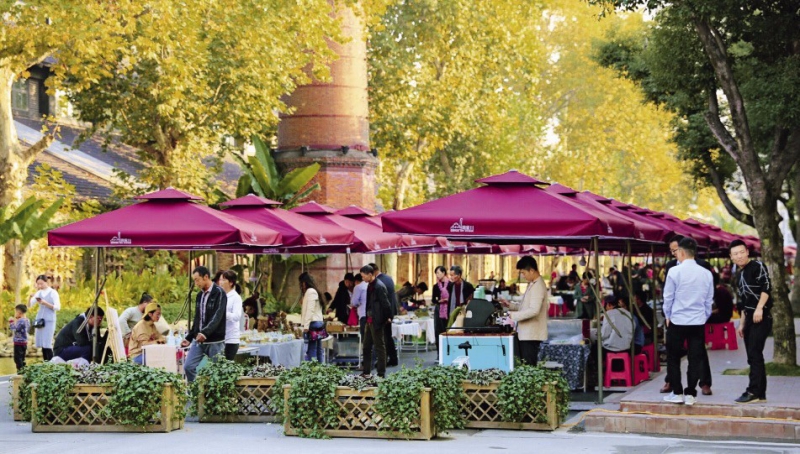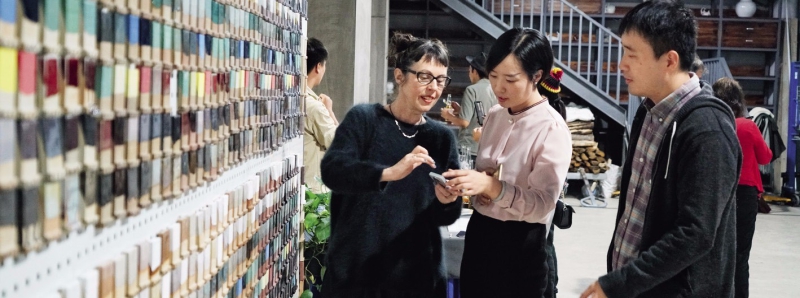
Feng Xuefang,a ceramic designer,transitioning from a dream chaser to a dream maker, has found her place in the world-famed ceramic capital Jingdezhen.
During the third year of postgraduate study, Feng returned to her hometown as an intern and worked as a designer at a local museum for half a year. Her parents wished her to live a stable and regular life, however, the daughter was thinking about what she wants and what life she wants to live. “Thinking it over, I decided to return to Jingdezhen, the place where I had been for seven years. Interest is the best teacher. Since I stayed there according to my wishes, I also did what I like!” said Feng.
Dream Chaser to Dream Maker
In the autumn of 2014, Feng and four partners founded a pottery studio called Juzijia (literally means Orange’s Home) to make unique and endearing works. However, it didn’t take long for the partners to be presented with new opportunities and choices, leaving Feng to run the studio alone.
During the hard time, she was told that Jingdezhen opened a creative market named Taoxichuan, and she visited it with excitement. It was based in the old plants of a closed ceramic factory and has been transformed into a district that integrates culture, creativity, and entertainment. It houses fashionable creative studios, ceramic shops, cafes, book bars, hotels, restaurants, and other elements that young people like.
Among them, the kiln of the old factory has been transformed into Yi Space, which is free for young entrepreneurs and artists to display and sell their ceramic works. Feng learned that due to limited space, the Yi Space has a set of selection and elimination mechanisms. Each month, more than 600 people are selected from entrepreneurial youths who submit applications to set up stalls at an outdoor market during weekends, and then some outstanding entrepreneurs are selected to enter and be displayed at Yi Space. Feng submitted her application. Soon, her ceramic products were not only selected to participate in the creative market, but also successfully became the first group of creators to settle in Yi Space.

Taoxichuan Creative Market provides entrepreneurial opportunities for young people who love ceramic art.
As a creator featured in Yi Space, Feng enjoyed the deduction and exemption policies including operating charges, utilities, and taxes. Her works were also selected for an online display and sales platform specifically for entrepreneurial youth. More importantly, by participating in some entrepreneurial training, she learned of cutting-edge ideas of well-known professors, artists, designers, and scholars from China and other countries such as those of the Ceramic Art Research Institute of the Central Academy of Fine Arts, the Taoxichuan Cultural Study Exchange Center, and other well-known institutions, which improved her creative level and allowed her to gradually complete the beautiful transformation from dream chaser to dream maker.
“Taoxichuan is a cultural district, and we don’t want others to regard it as an industrial park,” said Liu Zili, chairman of Jingdezhen Ceramic Culture Tourism Group, “What we build is not a store but a lifestyle. I hope Taoxichuan can become a dream creating space for young creators and artists. As long as they love ceramic art and have dreams, this can be home for them.”
Reinventing Oneself
Feng focuses on the designing and production of each product. Her design inspiration stems from everything in life. “The charm of ceramics lies in the simple texture of mud,” and she also conforms to this simple texture to reflect spirituality. “During the production process, you will find a lot of interesting details and hints, which are likely to be the source of inspiration for new design. Treat every process of making porcelain as a new attempt, and be curious about every detail like never before. Everything will become interesting. There is only one reference standard, which is whether I like it or not. With this standard, everything is simple,” said Feng.
In her studio, in addition to flower vases, there are also series of food containers. One of the series is named “warmth.” An ordinary fruit tray, under careful design and matching, has a distinctive style. The studio also launches new products, mainly the design and making of vintage vases, transforming from a production studio to a design studio.
“In 2016, Taoxichuan organized a group of creators to go to the Shenzhen International Cultural Industry Fair, and I was one of them,” Feng recalled, “I really thought that it was only to promote products, but in fact it wasn’t. Because the people who came to negotiate with us are from large platforms or independent organizations. In their eyes, we are designers, not just makers. Taoxichuan guides us to change to designers or other identities.”
When the product has its own style, it will bring in a stable flow of customers. “As entrepreneurs, making products is not the hardest, the most difficult is the lack of business-running knowledge,” said Feng, “Previously, we were waiting for customers to come. From this year we deliberately participated in some professional exhibitions to promote our products. We even collaborate with customers we have worked with before to organize exhibitions to promote our products.”

Feng Xuefang and a foreign artist exchange ceramic making experience.
Love with Ceramics
Feng not only gained her career success in Jingdezhen, but also found a like-minded life partner. They are alumni, both started businesses in Jingdezhen.
Four years ago, the staff of the Boao Forum for Asia came to her studio, hoping to order production of 300 Ao (a mythological turtle) as gifts for the guests. The Ao’s complex shapes make it difficult to make ceramic sculptures. After more than two months of design and polishing, Feng and her boyfriend (later her husband) innovated the making of glaze, especially the technique of seven colors burned out at 1300 degrees Celsius, winning love and recognition from foreign friends who participated in the forum. At that time, they were so excited. “I then made up my mind to marry this handsome guy who innovated with me,” Feng recalled happily.
Interestingly, they are ceramic creators with completely different styles. One is based on lively flowers and plants, the other favors complicated traditional themes such as Qilin (a mythical hooved chimerical creature); one is responsible for the whole process of production, supply, and marketing, the other focuses on creating quietly. Entrepreneurship enables them to support each other and then finally link up their efforts. They have been married for more than four years and have their baby. After marriage, they pay more attention to maintaining each other’s individuality and admiration for each other.
In April 2019, Taoxichuan and the European Ceramic Work Center co-hosted an international exhibition named TXC@Sundaymorning – a Taste of Ceramics, inviting nine artists from Chile, Spain, Sweden, the Netherlands, the United Kingdom, Germany, and India to participate. Most of these artists are on their first visits to Jingdezhen. In a different language environment, facing different materials and technologies, how to reasonably choose the corresponding materials and processes as well as reasonably arrange the work rhythm was very challenging for these artists. A British artist had 10 paintings unpainted before the exhibition. Seeing her anxious look, Feng took out hundreds of pigments for her reference, and after repeated experiments, she finally fired the colors she was satisfied with. Before returning to China, the British artist said with emotion: “Here they have the best craftsmen and the most complete porcelain making system, which is a paradise for potters around the world to create in.” She also made a cup expressing her gratitude. Taoxichuan has received many cups left by artists of different nationalities. Art has no national boundaries, and the fusion of cultures has made more artists feel the charm of Chinese ceramics.
“Jingdezhen has changed greatly during the past few years. And there are more platforms for exchange activities, as well as more opportunities and competition.” Fang smiled, “This is a good thing for Jingdezhen. Only by constantly colliding and communicating can new things appear. I just happened to chat with a Mexican artist a few days ago, and I asked him what he thought of Jingdezhen. He said he wanted to move Jingdezhen to his country. ”
“Looking back, everything from graduation to entrepreneurship seems to be natural, but there is an invisible force that has always supported me. That is the opportunity provided by Taoxichuan to creators. In the future, I hope I can be more free and lucky in the way I want,” Feng said with emotion.
Her free state of mind is enviable. In the future, Feng hopes that her products can meet people who understand it, as she says: “What I like is exactly what you like.”